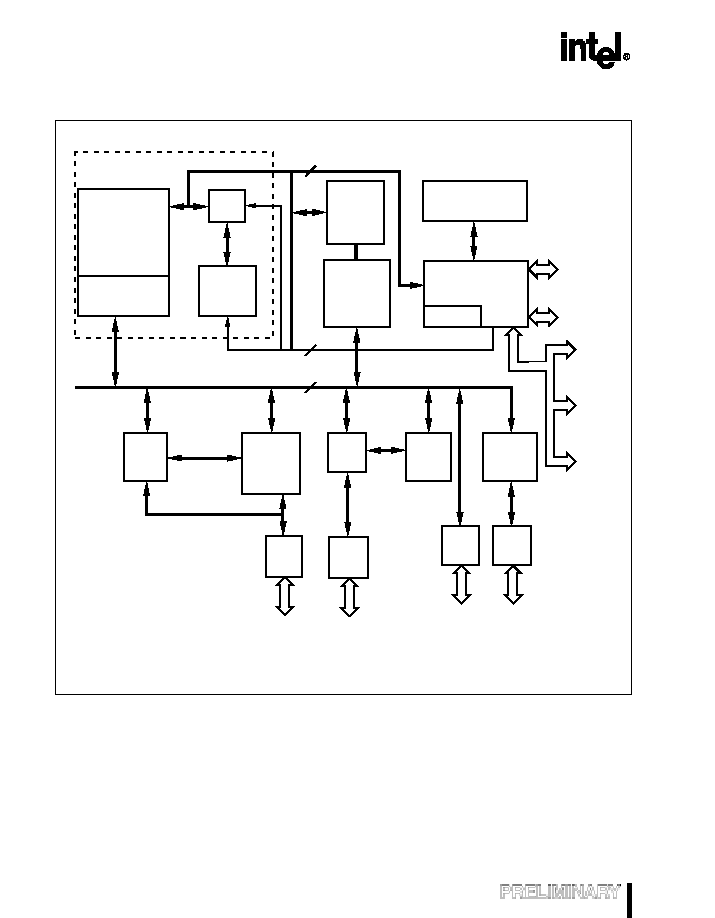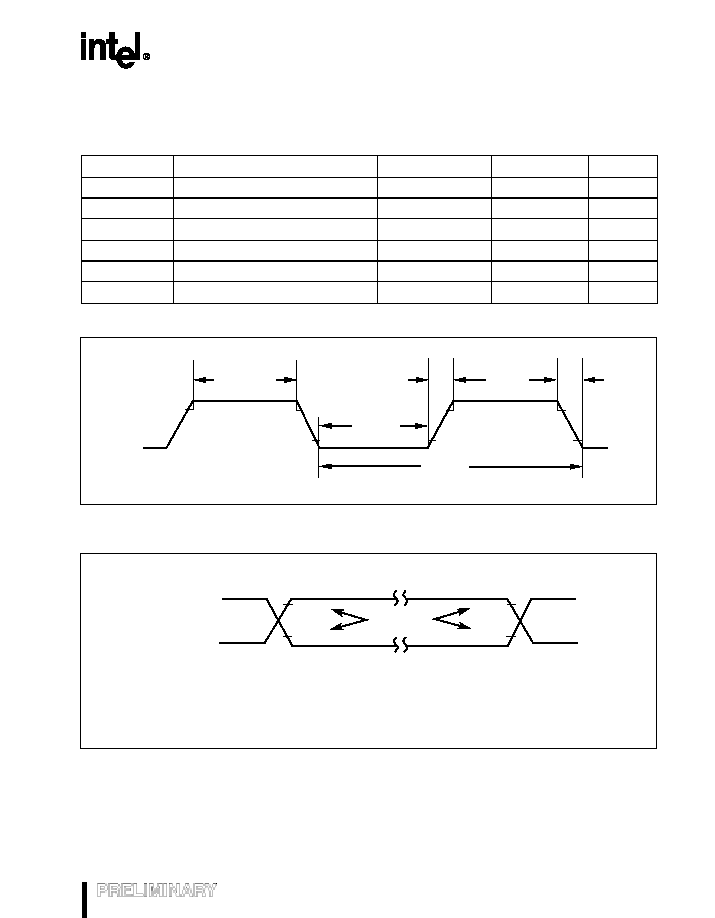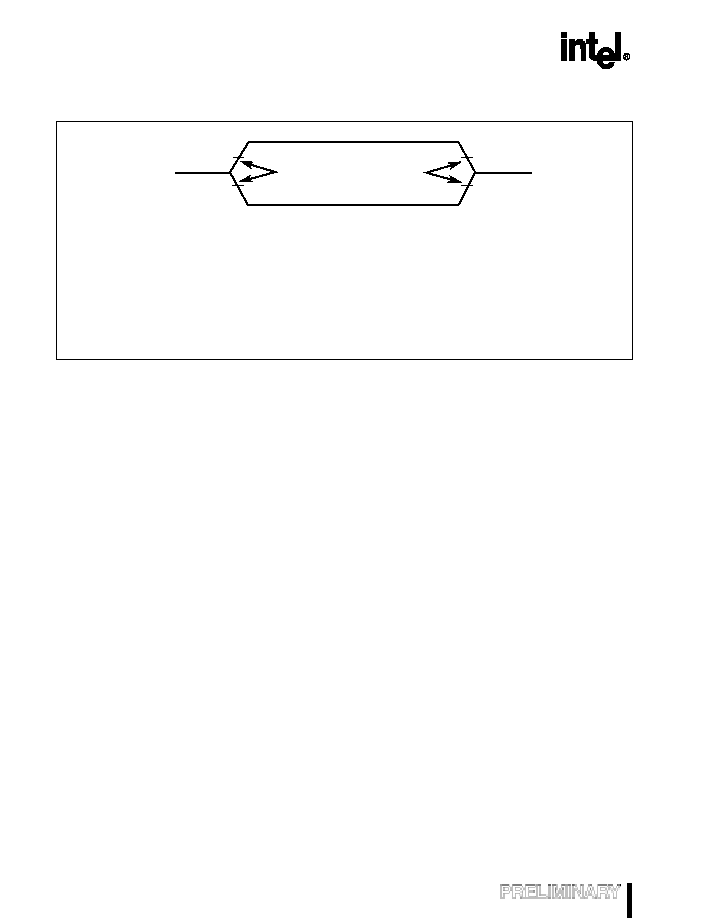 | –≠–ª–µ–∫—Ç—Ä–æ–Ω–Ω—ã–π –∫–æ–º–ø–æ–Ω–µ–Ω—Ç: 8XC196NP | –°–∫–∞—á–∞—Ç—å:  PDF PDF  ZIP ZIP |

Information in this document is provided solely to enable use of Intel products. Intel assumes no liability whatsoever, including infringe-
ment of any patent or copyright, for sale and use of Intel products except as provided in Intel's Terms and Conditions of Sale for such
products. Information contained herein supersedes previously published specifications on these devices from Intel.
© INTEL CORPORATION, 1995
October 1995
8XC196NP COMMERCIAL
CHMOS 16-BIT MICROCONTROLLER
The 8XC196NP is a member of Intel's 16-bit MCS
Æ
96 microcontroller family. The device features 1 Mbyte of
linear address space, a demultiplexed bus, and a chip-select unit. The external bus can dynamically switch
between multiplexed and demultiplexed operation. When operating at 25 MHz in demultiplexed mode, the
8XC196NP can access a 100 ns memory device with zero wait states. The 8XC196NP is available without
ROM (80C196NP) or with 4 Kbytes of ROM (83C196NP).
n
25 MHz Operation at 4.5≠5.5 Volts
n
1 Mbyte of Linear Address Space
n
Optional 4 Kbytes of ROM
n
1000 Bytes of Register RAM
n
Register-register Architecture
n
32 I/O Port Pins
n
16 Prioritized Interrupt Sources
n
4 External Interrupt Pins and NMI Pin
n
2 Flexible 16-bit Timer/Counters with
Quadrature Counting Capability
n
3 Pulse-width Modulator (PWM) Outputs
with High Drive Capability
n
Full-duplex Serial Port with Dedicated
Baud-rate Generator
n
Peripheral Transaction Server
n
Event Processor Array (EPA) with 4
High-speed Capture/Compare Channels
n
Chip-select Unit
-- 6 Chip Select Pins
-- Dynamic Demultiplexed/Multi-
plexed Address/Data Bus for Each
Chip Select
-- Programmable Wait States (0, 1, 2,
or 3) for Each Chip Select
-- Programmable Bus Width (8- or 16-
bit) for Each Chip Select
-- Programmable Address Range for
Each Chip Select
n
1.12
µ
s 16
◊
16 Unsigned
Multiplication
n
1.92
µ
s 32/16 Unsigned Division
n
100-pin SQFP or 100-pin QFP Package
n
Complete System Development
Support
n
High-speed CHMOS Technology
Order Number: 272459-005

8XC196NP COMMERCIAL CHMOS 16-BIT MICROCONTROLLER
2
Figure 1. 8XC196NP Block Diagram
Timer 1
Timer 2
Event
Processor
Array
Serial
Port
Baud
Rate
Gen
Port 2
Port 1
Port 1/
EPA3:0,
Timer 1,
Timer 2
Port 2/
Hold Control,
SIO,
EXTINT1:0
Pulse
Width
Modulator
Microcode
Engine
RALU
CPU
Peripheral
Transaction
Server
4K Bytes
ROM (optional)
AD15:0
A15:0
A19:16/
EPORT3:0
Chip Select
CS5:0#
Interrupt
Controller
16
16
8
1000
Byte
Register
File
24 Bytes
CPU SFRs
Memory Controller
with
Chip Select
Queue
Port
3
Port
4
Port 3/
EXTINT3:2
Port 4/
PWM2:0
A2351-01
Control
Signals

8XC196NP COMMERCIAL CHMOS 16-BIT MICROCONTROLLER
3
PROCESS INFORMATION
This device is manufactured on P648, a CHMOS IV
process. Additional process and reliability infor-
mation is available in Intel's
Components Quality
and Reliability Handbook
(order number 210997).
All thermal impedance data is approximate for static
air conditions at 1 watt of power dissipation. Values
will change depending on operating conditions and
the application. The Intel
Packaging Handbook
(order number 240800) describes Intel's thermal
impedance test methodology.
Table 1. Thermal Characteristics
Package Type
JA
JC
100-pin SQFP
55
∞
C/W
14
∞
C/W
100-pin QFP
56
∞
C/W
16
∞
C/W
Figure 2. The 8XC196NP Family Nomenclature
Table 2. Description of Product Nomenclature
Parameter
Options
Description
Temperature and Burn-in Options
no mark
Commercial operating temperature range (0∞C to 70∞C)
with Intel standard burn-in.
Packaging Options
S
SB
QFP
SQFP
Program≠memory Options
0
3
No ROM
ROM
Process Information
C
CHMOS
Product Family
196NP
Device Speed
no mark
25 MHz
Program-memory Options
XXXXX
XX
X
X
8
XX
X
Packaging Options
Temperature and Burn-in Options
A2815-01
Process Information
Product Family Device Speed

8XC196NP COMMERCIAL CHMOS 16-BIT MICROCONTROLLER
4
Table 3. 8XC196NP Memory Map
Address
(Note 1)
Description
Notes
FF FFFFH
FF 3000H
External device (memory or I/O) connected to address/data bus
9
FF 2FFFH
FF 2000H
Internal ROM or external device (memory or I/O) connected to address/data bus
(determined by EA# pin)
2,9
FF 1FFFH
FF 0000H
External device (memory or I/O) connected to address/data bus
3,9
FE FFFFH
0F 0000H
Overlaid memory (reserved for future devices)
3,9
0E FFFFH
01 0000H
896 Kbytes of external device (memory or I/O) connected to address/data bus
9
00 FFFFH
00 3000H
External device (memory or I/O) connected to address/data bus
9
00 2FFFH
00 2000H
External device (memory or I/O) connected to address/data bus or remapped
internal ROM
5, 6,9
00 1FFFH
00 1FE0H
Memory-mapped peripheral special-function registers (SFRs)
4, 7,9
00 1FDFH
00 1F00H
Internal peripheral special-function registers (SFRs)
4, 7, 10
00 1EFFH
00 0400H
External device (memory or I/O) (reserved for future devices)
6
00 03FFH
00 0100H
Upper register file (general-purpose register RAM)
8, 10
00 00FFH
00 0018H
Lower register file (general-purpose register RAM and stack pointer)
8, 11
00 0017H
00 0000H
Lower register file (CPU SFRs)
4, 7, 8, 11
NOTES:
1.
Internally, there are 24 address bits (A23:0); however, only 20 address lines (A19:0) are bonded out.
The external address space is 1 Mbyte (00000≠FFFFFH).
2.
The 8XC196NP resets to internal address FF2080H (FF2080H in internal ROM or F2080H in external
memory).
3.
Do not locate code in addresses
x
F0000≠
x
F00FFH. These addresses are reserved for the ICE in-cir-
cuit emulator. Unless otherwise noted, write 0FFH to reserved memory locations.
4.
Unless otherwise noted, write 0 to reserved SFR bits.
5.
These areas are mapped into internal ROM if the REMAP bit (CCB1.2) is set and EA# is at logic 1.
Otherwise, they are mapped to external memory.
6.
WARNING: The contents or functions of these memory locations may change with future device revi-
sions, in which case a program that relies on one or more of these locations may not function properly.
7.
Refer to the
8XC196NP User's Manual
or
8XC196NP Quick Reference
for SFR descriptions.
8.
Code executed in locations 000000H to 0003FFH will be forced external.
9.
Address with indirect, indexed, or extended modes.
10. Address with indirect, indexed, or extended modes or through register windows.
11. Address with direct, indirect, indexed, or extended modes.

8XC196NP COMMERCIAL CHMOS 16-BIT MICROCONTROLLER
5
Figure 3. 8XC196NP 100-pin SQFP Package
RD#
BHE# / WRH#
ALE
INST
READY
RPD
ONCE
V
SS
V
CC
V
SS
A8
A9
A10
A11
A12
A13
A14
A15
NC
V
SS
XTAL1
XTAL2
V
SS
NC
P2.7 / CLKOUT
AD0
AD1
AD2
AD3
AD4
AD5
AD6
AD7
V
CC
AD8
V
SS
AD9
AD10
AD11
AD12
AD13
AD14
AD15
A16 / EPORT.0
A17 / EPORT.1
V
CC
V
SS
A18 / EPORT.2
A19 / EPORT.3
WR# / WRL#
A2348-04
RESET#
NMI
EA#
A0
A1
V
CC
V
SS
A2
A3
A4
A5
A6
A7
V
CC
V
SS
NC
NC
P3.0 / CS0#
P3.1 / CS1#
P3.2 / CS2#
P3.3 / CS3#
V
SS
P3.4 / CS4#
P3.5 / CS5#
P3.6 / EXTINT2
75
74
73
72
71
70
69
68
67
66
65
64
63
62
61
60
59
58
57
56
55
54
53
52
51
SB8XC196NP
View of component as
mounted on PC board
1
2
3
4
5
6
7
8
9
10
11
12
13
14
15
16
17
18
19
20
21
22
23
24
25
P3.7 / EXTINT3
P1.0 / EPA0
V
CC
P1.1 / EPA1
P1.2 / EPA2
P1.3 / EPA3
P1.4 / T1CLK
P1.5 / T1DIR
V
CC
P1.6 / T2CLK
V
SS
P1.7 / T2DIR
P4.0 / PWM0
P4.1 / PWM1
P4.2 / PWM2
P4.3
V
CC
V
SS
P2.0 / TXD
P2.1 / RXD
P2.2 / EXTINT0
P2.3 / BREQ#
P2.4 / EXTINT1
P2.5 / HOLD#
P2.6 / HLDA#
26
27
28
29
30
31
32
33
34
35
36
37
38
39
40
41
42
43
44
45
46
47
48
49
50
100
99
98
97
96
95
94
93
92
91
90
89
88
87
86
85
84
83
82
81
80
79
78
77
76

8XC196NP COMMERCIAL CHMOS 16-BIT MICROCONTROLLER
6
Table 4. 8XC196NP 100-pin SQFP Pin Assignment
Pin
Name
Pin
Name
Pin
Name
Pin
Name
1
RESET#
26
EXTINT3/P3.7
51
CLKOUT/P2.7
76
WR#/WRL#
2
NMI
27
EPA0/P1.0
52
NC
77
EPORT.3/A19
3
EA#
28
V
CC
53
V
SS
78
EPORT.2/A18
4
A0
29
EPA1/P1.1
54
XTAL2
79
V
SS
5
A1
30
EPA2/P1.2
55
XTAL1
80
V
CC
6
V
CC
31
EPA3/P1.3
56
V
SS
81
EPORT.1/A17
7
V
SS
32
T1CLK/P1.4
57
NC
82
EPORT.0/A16
8
A2
33
T1DIR/P1.5
58
A15
83
AD15
9
A3
34
V
CC
59
A14
84
AD14
10
A4
35
T2CLK/P1.6
60
A13
85
AD13
11
A5
36
V
SS
61
A12
86
AD12
12
A6
37
T2DIR/P1.7
62
A11
87
AD11
13
A7
38
PWM0/P4.0
63
A10
88
AD10
14
V
CC
39
PWM1/P4.1
64
A9
89
AD9
15
V
SS
40
PWM2/P4.2
65
A8
90
V
SS
16
NC
41
P4.3
66
V
SS
91
AD8
17
NC
42
V
CC
67
V
CC
92
V
CC
18
CS0#/P3.0
43
V
SS
68
V
SS
93
AD7
19
CS1#/P3.1
44
TXD/P2.0
69
ONCE
94
AD6
20
CS2#/P3.2
45
RXD/P2.1
70
RPD
95
AD5
21
CS3#/P3.3
46
EXTINT0/P2.2
71
READY
96
AD4
22
V
SS
47
BREQ#/P2.3
72
INST
97
AD3
23
CS4#/P3.4
48
EXTINT1/P2.4
73
ALE
98
AD2
24
CS5#/P3.5
49
HOLD#/P2.5
74
BHE#/WRH#
99
AD1
25
EXTINT2/P3.6
50
HLDA#/P2.6
75
RD#
100
AD0
To be compatible with future versions of the N
x
family, tie the no connection (NC) pins as follows:
Pin 57 = V
SS
, Pin 16 = V
CC
, Pin 17 = V
SS
(5 volts on this pin will enable a clock doubler on future
devices), and Pin 52 = V
CC
.

8XC196NP COMMERCIAL CHMOS 16-BIT MICROCONTROLLER
7
Table 5. 100-pin SQFP Pin Assignment Arranged by Functional Categories
Address & Data
Address & Data (cont)
Input/Output
Power & Ground
Name
Pin
Name
Pin
Name
Pin
Name
Pin
A0
4
AD13
85
CS0#/P3.0
18
V
CC
6
A1
5
AD14
84
CS1#/P3.1
19
V
CC
14
A2
8
AD15
83
CS2#/P3.2
20
V
CC
28
A3
9
CS3#/P3.3
21
V
CC
34
A4
10
Bus Control & Status
CS4#/P3.4
23
V
CC
42
A5
11
Name
Pin
CS5#/P3.5
24
V
CC
67
A6
12
ALE
73
EPA0/P1.0
27
V
CC
80
A7
13
BHE#/WRH#
74
EPA1/P1.1
29
V
CC
92
A8
65
BREQ#
47
EPA2/P1.2
30
V
SS
7
A9
64
HOLD#
49
EPA3/P1.3
31
V
SS
15
A10
63
HLDA#
50
EPORT.0
82
V
SS
22
A11
62
INST
72
EPORT.1
81
V
SS
36
A12
61
RD#
75
EPORT.2
78
V
SS
43
A13
60
READY
71
EPORT.3
77
V
SS
53
A14
59
WR#/WRL#
76
P2.2
46
V
SS
56
A15
58
P2.3
47
V
SS
66
A16
82
Processor Control
P2.4
48
V
SS
68
A17
81
Name
Pin
P2.5
49
V
SS
79
A18
78
CLKOUT
51
P2.6
50
V
SS
90
A19
77
EA#
3
P2.7
51
AD0
100
EXTINT0
46
P3.6
25
No Connection
AD1
99
EXTINT1
48
P3.7
26
Name
Pin
AD2
98
EXTINT2
25
P4.3
41
NC
16
AD3
97
EXTINT3
26
PWM0/P4.0
38
NC
17
AD4
96
NMI
2
PWM1/P4.1
39
NC
52
AD5
95
ONCE
69
PWM2/P4.2
40
NC
57
AD6
94
RESET#
1
RXD/P2.1
45
AD7
93
RPD
70
T1CLK/P1.4
32
AD8
91
XTAL1
55
T1DIR/P1.5
33
AD9
89
XTAL2
54
T2CLK/P1.6
35
AD10
88
T2DIR/P1.7
37
AD11
87
TXD/P2.0
44
AD12
86

8XC196NP COMMERCIAL CHMOS 16-BIT MICROCONTROLLER
8
Figure 4. 8XC196NP 100-pin QFP Package
V
SS
A18 / EPORT.2
A19 / EPORT.3
WR# / WRL#
RD#
BHE# / WRH#
ALE
INST
READY
RPD
ONCE
V
SS
V
CC
V
SS
A8
A9
A10
A11
A12
A13
A14
A15
V
SS
XTAL1
XTAL2
V
SS
P2.7 / CLKOUT
NC
P2.6 / HLDA#
P2.5 / HOLD#
AD1
AD2
AD3
AD4
AD5
AD6
AD7
V
CC
AD8
V
SS
AD9
AD10
AD11
AD12
AD13
AD14
AD15
A16 / EPORT.0
A17 / EPORT.1
V
CC
A2349-03
AD0
NC
RESET#
NMI
EA#
A0
A1
V
CC
V
SS
A2
A3
A4
A5
A6
A7
V
CC
V
SS
NC
P3.0 / CS0#
P3.1 / CS1#
P3.2 / CS2#
P3.3 / CS3#
V
SS
P3.4 / CS4#
P3.5 / CS5#
P3.6 / EXTINT2
NC
P3.7 / EXTINT3
P1.0 / EPA0
V
CC
80
79
78
77
76
75
74
73
72
71
70
69
68
67
66
65
64
63
62
61
60
59
58
57
56
55
54
53
52
51
S8XC196NP
View of component as
mounted on PC board
1
2
3
4
5
6
7
8
9
10
11
12
13
14
15
16
17
18
19
20
21
22
23
24
25
26
27
28
29
30
P1.1 / EPA1
P1.2 / EPA2
P1.3 / EPA3
P1.4 / T1CLK
P1.5 / T1DIR
V
CC
P1.6 / T2CLK
V
SS
P1.7 / T2DIR
P4.0 / PWM0
P4.1 / PWM1
P4.2 / PWM2
P4.3
V
CC
V
SS
P2.0 / TXD
P2.1 / RXD
P2.2 / EXTINT0
P2.3 / BREQ#
P2.4 / EXTINT1
31
32
33
34
35
36
37
38
39
40
41
42
43
44
45
46
47
48
49
50
100
99
98
97
96
95
94
93
92
91
90
89
88
87
86
85
84
83
82
81

8XC196NP COMMERCIAL CHMOS 16-BIT MICROCONTROLLER
9
Table 6. 8XC196NP 100-pin QFP Pin Assignment
Pin
Name
Pin
Name
Pin
Name
Pin
Name
1
AD0
26
EXTINT2/P3.6
51
HOLD#/P2.5
76
RD#
2
No Connection
27
No Connection
52
HLDA#/P2.6
77
WR#/WRL#
3
RESET#
28
EXTINT3/P3.7
53
No Connection
78
EPORT.3/A19
4
NMI
29
EPA0/P1.0
54
CLKOUT/P2.7
79
EPORT.2/A18
5
EA#
30
V
CC
55
V
SS
80
V
SS
6
A0
31
EPA1/P1.1
56
XTAL2
81
V
CC
7
A1
32
EPA2/P1.2
57
XTAL1
82
EPORT.1/A17
8
V
CC
33
EPA3/P1.3
58
V
SS
83
EPORT.0/A16
9
V
SS
34
T1CLK/P1.4
59
A15
84
AD15
10
A2
35
T1DIR/P1.5
60
A14
85
AD14
11
A3
36
V
CC
61
A13
86
AD13
12
A4
37
T2CLK/P1.6
62
A12
87
AD12
13
A5
38
V
SS
63
A11
88
AD11
14
A6
39
T2DIR/P1.7
64
A10
89
AD10
15
A7
40
PWM0/P4.0
65
A9
90
AD9
16
V
CC
41
PWM1/P4.1
66
A8
91
V
SS
17
V
SS
42
PWM2/P4.2
67
V
SS
92
AD8
18
No Connection
43
P4.3
68
V
CC
93
V
CC
19
CS0#/P3.0
44
V
CC
69
V
SS
94
AD7
20
CS1#/P3.1
45
V
SS
70
ONCE
95
AD6
21
CS2#/P3.2
46
TXD/P2.0
71
RPD
96
AD5
22
CS3#/P3.3
47
RXD/P2.1
72
READY
97
AD4
23
V
SS
48
EXTINT0/P2.2
73
INST
98
AD3
24
CS4#/P3.4
49
BREQ#/P2.3
74
ALE
99
AD2
25
CS5#/P3.5
50
EXTINT1/P2.4
75
BHE#/WRH#
100
AD1

8XC196NP COMMERCIAL CHMOS 16-BIT MICROCONTROLLER
10
Table 7. 100-pin QFP Pin Assignment Arranged by Functional Categories
Address & Data
Address & Data (cont)
Input/Output
Power & Ground
Name
Pin
Name
Pin
Name
Pin
Name
Pin
A0
6
AD13
86
CS0#/P3.0
19
V
CC
8
A1
7
AD14
85
CS1#/P3.1
20
V
CC
16
A2
10
AD15
84
CS2#/P3.2
21
V
CC
30
A3
11
CS3#/P3.3
22
V
CC
36
A4
12
Bus Control & Status
CS4#/P3.4
24
V
CC
44
A5
13
Name
Pin
CS5#/P3.5
25
V
CC
68
A6
14
ALE
74
EPA0/P1.0
29
V
CC
81
A7
15
BHE#/WRH#
75
EPA1/P1.1
31
V
CC
93
A8
66
BREQ#
49
EPA2/P1.2
32
V
SS
9
A9
65
HOLD#
51
EPA3/P1.3
33
V
SS
17
A10
64
HLDA#
52
EPORT.0
83
V
SS
23
A11
63
INST
73
EPORT.1
82
V
SS
38
A12
62
RD#
76
EPORT.2
79
V
SS
45
A13
61
READY
72
EPORT.3
78
V
SS
55
A14
60
WR#/WRL#
77
P2.2
48
V
SS
58
A15
59
P2.3
49
V
SS
67
A16
83
Processor Control
P2.4
50
V
SS
69
A17
82
Name
Pin
P2.5
51
V
SS
80
A18
79
CLKOUT
54
P2.6
52
V
SS
91
A19
78
EA#
5
P2.7
54
AD0
1
EXTINT0
48
P3.6
26
No Connection
AD1
100
EXTINT1
50
P3.7
28
Name
Pin
AD2
99
EXTINT2
26
P4.3
43
NC
2
AD3
98
EXTINT3
28
PWM0/P4.0
40
NC
18
AD4
97
NMI
4
PWM1/P4.1
41
NC
27
AD5
96
ONCE
70
PWM2/P4.2
42
NC
53
AD6
95
RESET#
3
RXD/P2.1
47
AD7
94
RPD
71
T1CLK/P1.4
34
AD8
92
XTAL1
57
T1DIR/P1.5
35
AD9
90
XTAL2
56
T2CLK/P1.6
37
AD10
89
T2DIR/P1.7
39
AD11
88
TXD/P2.0
46
AD12
87

8XC196NP COMMERCIAL CHMOS 16-BIT MICROCONTROLLER
11
PIN DESCRIPTIONS
Table 8. Pin Descriptions
Name
Type
Description
Multiplexed
with
A15:0
I/O
System Address Bus
These address lines provide address bits 0≠15 during the entire
external memory cycle during both multiplexed and demultiplexed
bus modes.
--
A19:16
I/O
Address Lines 16≠19
These address lines provide address bits 16≠19 during the entire
external memory cycle, supporting extended addressing of the 1-
Mbyte address space.
Internally, there are 24 address bits; however, only 20 address lines
(A19:0) are bonded out. The external address space is 1 Mbyte
(00000≠FFFFFH) and the internal address space is 16 Mbytes
(000000≠FFFFFFH). The 8XC196NP resets to internal address
FF2080H (FF2080H in internal ROM or F2080H in external
memory).
EPORT.3:0
AD15:0
I/O
Address/Data Lines
The function of these pins depends on the bus size and mode.
16-bit Multiplexed Bus Mode:
AD15:0 drive address bits 0≠15 during the first half of the bus cycle
and drive or receive data during the second half of the bus cycle.
8-bit Multiplexed Bus Mode:
AD15:8 drive address bits 8≠15 during the entire bus cycle. AD7:0
drive address bits 0≠7 during the first half of the bus cycle and drive
or receive data during the second half of the bus cycle.
16-bit Demultiplexed Mode:
AD15:0 drive or receive data during the entire bus cycle.
8-bit Demultiplexed Mode:
AD7:0 drive or receive data during the entire bus cycle. AD15:8
drive the data that is currently on the high byte of the internal bus.
--
ALE
O
Address Latch Enable
This active-high output signal is asserted only during external
memory cycles. ALE signals the start of an external bus cycle and
indicates that valid address information is available on the system
address/data bus (A19:16 and AD15:0 for a multiplexed bus; A19:0
for a demultiplexed bus). ALE differs from ADV# in that it does not
remain active during the entire bus cycle.
An external latch can use this signal to demultiplex the address bits
0≠15 from the address/data bus in multiplexed mode.
--

8XC196NP COMMERCIAL CHMOS 16-BIT MICROCONTROLLER
12
BHE#
O
Byte High Enable
The chip configuration register 0 (CCR0) determines whether this
pin functions as BHE# or WRH#. CCR0.2=1 selects BHE#;
CCR0.2=0 selects WRH#.
During 16-bit bus cycles, this active-low output signal is asserted for
word reads and writes and high-byte reads and writes to external
memory. BHE# indicates that valid data is being transferred over
the upper half of the system data bus. Use BHE#, in conjunction
with A0, to determine which memory byte is being transferred over
the system bus:
BHE#
A0
Byte(s) Accessed
0
0
both bytes
0
1
high byte only
1
0
low byte only
WRH#
BREQ#
O
Bus Request
This active-low output signal is asserted during a hold cycle when
the bus controller has a pending external memory cycle.
The device can assert BREQ# at the same time as or after it asserts
HLDA#. Once it is asserted, BREQ# remains asserted until HOLD#
is removed.
You must enable the bus-hold protocol before using this signal.
P2.3
CLKOUT
O
Clock Output
Output of the internal clock generator. The CLKOUT frequency is Ω
the internal operating frequency (F
XTAL
1
). CLKOUT has a 50% duty
cycle.
P2.7
CS5#:0
O
Chip-select Lines 0≠5
The active-low output CS
x
# is asserted during an external memory
cycle when the address to be accessed is in the range programmed
for chip select
x
. If the external memory address is outside the
range assigned to the six chip selects, no chip-select output is
asserted and the bus configuration defaults to the CS5# values.
Immediately following reset, CS0# is automatically assigned to the
range FF2000≠FF20FFH (F2000≠F20FFH if external).
P3.5:0
EA#
I
External Access
This input determines whether memory accesses to special-
purpose and program memory partitions (FF2000≠FF2FFFH) are
directed to internal or external memory. These accesses are
directed to internal memory if EA# is held high and to external
memory if EA# is held low. For an access to any other memory
location, the value of EA# is irrelevant.
EA# is not latched and can be switched dynamically during normal
operating mode. Be sure to thoroughly consider the issues, such as
different access times for internal and external memory, before
using this dynamic switching capability.
On devices with no internal nonvolatile memory, always connect
EA# to V
SS
.
--
Table 8. Pin Descriptions (Continued)
Name
Type
Description
Multiplexed
with

8XC196NP COMMERCIAL CHMOS 16-BIT MICROCONTROLLER
13
EPA3:0
I/O
Event Processor Array (EPA) Input/Output pins
These are the high-speed input/output pins for the EPA
capture/compare channels. For high-speed PWM applications, the
outputs of two EPA channels (either EPA0 and EPA1 or EPA2 and
EPA3) can be remapped to produce a PWM waveform on a shared
output pin.
P1.3:0
EPORT.3:0
I/O
Extended Addressing Port
This is a 4-bit, bidirectional, memory-mapped I/O port. The pins are
shared with the extended address bus A19:16.
A19:16
EXTINT0
EXTINT1
EXTINT2
EXTINT3
I
External Interrupts
In normal operating mode, a rising edge on EXTINT
x
sets the
EXTINT
x
interrupt pending bit. EXTINT
x
is sampled during phase 2
(CLKOUT high). The minimum high time is one state time.
In powerdown mode, asserting the EXTINT
x
signal for at least 1
state time causes the device to resume normal operation. The
interrupt need not be enabled, but the pin must be configured as a
special-function input. If the EXTINT
x
interrupt is enabled, the CPU
executes the interrupt service routine. Otherwise, the CPU executes
the instruction that immediately follows the command that invoked
the power-saving mode.
In idle mode, asserting any enabled interrupt causes the device to
resume normal operation.
P2.2
P2.4
P3.6
P3.7
HLDA#
O
Bus Hold Acknowledge
This active-low output indicates that the CPU has released the bus
as the result of an external device asserting HOLD#.
P2.6
HOLD#
I
Bus Hold Request
An external device uses this active-low input signal to request
control of the bus. This pin functions as HOLD# only if the pin is
configured for its special function and the bus-hold protocol is
enabled. Setting bit 7 of the window selection register enables the
bus-hold protocol.
P2.5
INST
O
Instruction Fetch
This active-high output signal is valid only during external memory
bus cycles. When high, INST indicates that an instruction is being
fetched from external memory. The signal remains high during the
entire bus cycle of an external instruction fetch. INST is low for data
accesses, including interrupt vector fetches and chip configuration
byte reads. INST is low during internal memory fetches.
--
NMI
I
Nonmaskable Interrupt
In normal operating mode, a rising edge on NMI generates a
nonmaskable interrupt. NMI has the highest priority of all prioritized
interrupts. Assert NMI for greater than one state time to guarantee
that it is recognized.
--
Table 8. Pin Descriptions (Continued)
Name
Type
Description
Multiplexed
with

8XC196NP COMMERCIAL CHMOS 16-BIT MICROCONTROLLER
14
ONCE
I
On-circuit Emulation
Holding ONCE high during the rising edge of RESET# places the
device into on-circuit emulation (ONCE) mode. This mode puts all
pins into a high-impedance state, thereby isolating the device from
other components in the system. The value of ONCE is latched
when the RESET# pin goes inactive. While the device is in ONCE
mode, you can debug the system using a clip-on emulator. To exit
ONCE mode, reset the device by pulling the RESET# signal low.
To prevent accidental entry into ONCE mode, connect the ONCE
pin to V
SS
.
--
P1.3:0
P1.4
P1.5
P1.6
P1.7
I/O
Port 1
This is a standard, bidirectional port that is multiplexed with individ-
ually selectable special-function signals.
EPA3:0
T1CLK
T1DIR
T2CLK
T2DIR
P2.0
P2.1
P2.2
P2.3
P2.4
P2.5
P2.6
P2.7
I/O
Port 2
This is a standard, bidirectional port that is multiplexed with individ-
ually selectable special-function signals.
TXD
RXD
EXTINT0
BREQ#
EXTINT1
HOLD#
HLDA#
CLKOUT
P3.5:0
P3.6
P3.7
I/O
Port 3
This is an 8-bit, bidirectional, standard I/O port.
CS5:0#
EXTINT2
EXTINT3
P4.2:0
P4.3
I/O
Port 4
This is a 4-bit, bidirectional, standard I/O port with high-current drive
capability.
PWM2:0
PWM2:0
O
Pulse Width Modulator Outputs
These are PWM output pins with high-current drive capability. The
duty cycle and frequency-pulse-widths are programmable.
P4.2:0
RD#
O
Read
Read-signal output to external memory. RD# is asserted only during
external memory reads.
--
READY
I
Ready Input
This active-high input signal is used to lengthen external memory
cycles for slow memory by generating wait states in addition to the
wait states that are generated internally.
When READY is high, CPU operation continues in a normal manner
with wait states inserted as programmed in the chip configuration
registers, Register 0, or the chip-select
x
bus control register.
READY is ignored for all internal memory accesses.
--
Table 8. Pin Descriptions (Continued)
Name
Type
Description
Multiplexed
with

8XC196NP COMMERCIAL CHMOS 16-BIT MICROCONTROLLER
15
RESET#
I/O
Reset
A level-sensitive reset input to and open-drain system reset output
from the microcontroller. Either a falling edge on RESET# or an
internal reset turns on a pull-down transistor connected to the
RESET# pin for 16 state times. In the powerdown, standby, and idle
modes, asserting RESET# causes the chip to reset and return to
normal operating mode. After a device reset, the first instruction
fetch is from FF2080H (or F2080H in external memory). For the
80C196NP, the program and special-purpose memory locations
(FF2000≠FF2FFFH) reside in external memory. For the 83C196NP,
these locations can reside either in external memory or in internal
ROM.
--
RPD
I
Return from Powerdown
Timing pin for the return-from-powerdown circuit.
If your application uses powerdown mode, connect a capacitor
between RPD and V
SS
if the internal oscillator is the clock source.
The capacitor causes a delay that enables the oscillator to stabilize
before the internal CPU and peripheral clocks are enabled.
The capacitor is not required if your application uses powerdown
mode and if an external clock input is the clock source.
If your application does not use powerdown mode, leave this pin
unconnected.
--
RXD
I/O
Receive Serial Data
In modes 1, 2, and 3, RXD receives serial port input data. In mode
0, it functions as either an input or an open-drain output for data.
P2.1
T1CLK
I
Timer 1 External Clock
External clock for timer 1. Timer 1 increments (or decrements) on
both rising and falling edges of T1CLK. Also used in conjunction
with T1DIR for quadrature counting mode.
and
External clock for the serial I/O baud-rate generator input (program
selectable).
P1.4
T2CLK
I
Timer 2 External Clock
External clock for timer 2. Timer 2 increments (or decrements) on
both rising and falling edges of T2CLK. Also used in conjunction
with T2DIR for quadrature counting mode.
P1.6
T1DIR
I
Timer 1 External Direction
External direction (up/down) for timer 1. Timer 1 increments when
T1DIR is high and decrements when it is low. Also used in
conjunction with T1CLK for quadrature counting mode.
P1.5
T2DIR
I
Timer 2 External Direction
External direction (up/down) for timer 2. Timer 2 increments when
T2DIR is high and decrements when it is low. Also used in
conjunction with T2CLK for quadrature counting mode.
P1.7
Table 8. Pin Descriptions (Continued)
Name
Type
Description
Multiplexed
with

8XC196NP COMMERCIAL CHMOS 16-BIT MICROCONTROLLER
16
ELECTRICAL CHARACTERISTICS
TXD
O
Transmit Serial Data
In serial I/O modes 1, 2, and 3, TXD is used to transmit serial port
data. In mode 0, it is used as the serial clock output.
P2.0
V
CC
PWR
Digital Supply Voltage
Connect each V
CC
pin to the digital supply voltage.
--
V
SS
GND
Digital Circuit Ground
Connect each V
SS
pin to ground through the lowest possible
impedance path.
--
WR#
O
Write
This active-low output indicates that an external write is occurring.
This signal is asserted only during external memory writes.
The chip configuration register 0 (CCR0) determines whether this
pin functions as WR# or WRL#. CCR0.2=1 selects WR#; CCR0.2=0
selects WRL#.
WRL#
WRH#
O
Write High
During 16-bit bus cycles, this active-low output signal is asserted for
high-byte writes and word writes to external memory. During 8-bit
bus cycles, WRH# is asserted for all write operations.
The chip configuration register 0 (CCR0) determines whether this
pin functions as BHE# or WRH#. CCR0.2=1 selects BHE#;
CCR0.2=0 selects WRH#.
BHE#
WRL#
O
Write Low
During 16-bit bus cycles, this active-low output signal is asserted for
low-byte writes and word writes. During 8-bit bus cycles, WRL# is
asserted for all write operations.
The chip configuration register 0 (CCR0) determines whether this
pin functions as WR# or WRL#. CCR0.2=1 selects WR#; CCR0.2=0
selects WRL#.
WR#
XTAL1
I
Input Crystal/Resonator or External Clock Input
Input to the on-chip oscillator and the internal clock generators. The
internal clock generators provide the peripheral clocks, CPU clock,
and CLKOUT signal. When using an external clock source instead
of the on-chip oscillator, connect the clock input to XTAL1. The
external clock signal must meet the V
IH
specification for XTAL1.
--
XTAL2
O
Inverted Output for the Crystal/Resonator
Output of the on-chip oscillator inverter. Leave XTAL2 floating when
the design uses an external clock source instead of the on-chip
oscillator.
--
Table 8. Pin Descriptions (Continued)
Name
Type
Description
Multiplexed
with

8XC196NP COMMERCIAL CHMOS 16-BIT MICROCONTROLLER
17
ABSOLUTE MAXIMUM RATINGS*
Storage Temperature .................................. ≠60∞C to +150∞C
Supply Voltage with Respect to V
SS
.............. ≠0.5 V to +7.0 V
Power Dissipation .......................................................... 1.5 W
OPERATING CONDITIONS*
T
A
(Ambient Temperature Under Bias)................ 0∞C to +70∞C
V
CC
(Digital Supply Voltage) ............................. 4.5 V to 5.5 V
F
XTAL
1
(Input frequency for V
CC
= 4.5≠5.5 V)
(Note 1) ................................................. 8 MHz to 25 MHz
NOTES:
1.
This device is static and should operate below 1 Hz, but
has been tested only down to 8 MHz.
NOTICE: This document contains information on
products in the design phase of development. The
specifications are subject to change without notice.
Do not finalize a design with this information.
Revised information will be published when the
product is available. Verify with your local Intel
sales office that you have the latest datasheet
before finalizing a design.
*WARNING: Stressing the device beyond the "Absolute
Maximum Ratings" may cause permanent damage. These
are stress ratings only. Operation beyond the "Operating
Conditions" is not recommended and extended exposure
beyond the "Operating Conditions" may affect device reli-
ability.

8XC196NP COMMERCIAL CHMOS 16-BIT MICROCONTROLLER
18
DC Characteristics
Table 9. DC Characteristics at V
CC
= 4.5 ≠ 5.5 V (Note 1)
Symbol
Parameter
Min
Ty
p
Max
Units
Test Conditions
I
CC
V
CC
Supply Current
80
120
mA
XTAL1 = 25 MHz
V
CC
= 5.5 V
Device in Reset
I
IDLE
Idle Mode Current
24
36
mA
XTAL1 = 25 MHz
V
CC
= 5.5 V
I
PD
Powerdown Mode Current
(Note 2)
50
75
µA
V
CC
= 5.5 V
I
LI
Input Leakage Current
(all input pins except RESET)
±
10
µA
V
SS
< V
IN
< V
CC
V
IL
Input Low Voltage (all pins)
≠0.5
0.8
V
V
IH
Input High Voltage
0.2 V
CC
+1
V
CC
+ 0.5
V
V
IL
1
Input Low Voltage XTAL1
≠0.5
0.3 V
CC
V
V
IH
1
Input High Voltage XTAL1
0.7 V
CC
V
CC
+ 0.5
V
V
OL
Output Low Voltage (output
configured as complementary)
(Note 3,6)
0.3
0.45
1.5
V
V
V
I
OL
= 200 µA
I
OL
= 3.2 mA
I
OL
= 7.0 mA
V
OH
Output High Voltage (output
configured as complementary)
(Note 6)
V
CC
≠ 0.3
V
CC
≠ 0.7
V
CC
≠ 1.5
V
V
V
I
OH
= ≠200 µA
I
OH
= ≠3.2 mA
I
OH
= ≠7.0 mA
V
OL
1
Output Low Voltage on P4.
x
(output configured as comple-
mentary)
0.45
0.6
V
V
I
OL
= 10 mA
I
OL
= 15 mA
NOTES:
1.
Typical values are based on a limited number of samples and are not guaranteed. The values listed
are at room temperature with V
CC
= 5.0 V.
2.
For temperatures below 100
∞C
, typical is 10 µA.
3.
For all pins except P4.3:0, which have higher drive capability (see V
OL
1
).
4.
For all pins that were weakly pulled high during RESET. This excludes ALE, INST, and NMI, which
were weakly pulled low (see V
OL
2
) and ONCE, which was pulled medium low (see V
OL
3
).
5.
Pin capacitance is not tested. C
S
is based on design simulations.
6.
During normal (non-transient) conditions, the following maximum current limits apply for pin groups
and individual pins:
Group
I
OL
(mA)
I
OH
(mA)
P1
42
42
P2
42
42
P3
42
42
P4
45
21
EPORT
21
21
Individual
P1, P2, P3
10
10
P4
18
10

8XC196NP COMMERCIAL CHMOS 16-BIT MICROCONTROLLER
19
V
OL
2
Output Low Voltage in RESET
on ALE, INST, and NMI
0.45
V
I
OL
= 3 µA
V
OH
1
Output High Voltage in RESET
(Note 4)
V
CC
≠ 0.7
V
I
OH
= ≠3 µA
V
OL
3
Output Low Voltage in RESET
for ONCE pin
0.45
V
I
OL
= 30 µA
V
OL
4
Output Low Voltage on XTAL2
0.3
0.45
1.5
V
V
V
I
OL
= 100 µA
I
OL
= 700 µA
I
OL
= 3 mA
V
OH
2
Output High Voltage on XTAL2
V
CC
≠ 0.3
V
CC
≠ 0.7
V
CC
≠ 1.5
V
V
V
I
OH
= ≠100 µA
I
OH
= ≠700 µA
I
OH
= ≠3 mA
V
TH
+
≠V
TH
≠
Hysteresis voltage width on
RESET# pin
0.3
V
C
S
Pin Capacitance (any pin to
V
SS
) (Note 5)
10 pF
R
RST
RESET Pull-up Resistor
9
95
k
V
CC
= 5.5 V,
V
IN
= 4.0 V
Table 9. DC Characteristics at V
CC
= 4.5 ≠ 5.5 V (Note 1) (Continued)
Symbol
Parameter
Min
Ty
p
Max
Units
Test Conditions
NOTES:
1.
Typical values are based on a limited number of samples and are not guaranteed. The values listed
are at room temperature with V
CC
= 5.0 V.
2.
For temperatures below 100
∞C
, typical is 10 µA.
3.
For all pins except P4.3:0, which have higher drive capability (see V
OL
1
).
4.
For all pins that were weakly pulled high during RESET. This excludes ALE, INST, and NMI, which
were weakly pulled low (see V
OL
2
) and ONCE, which was pulled medium low (see V
OL
3
).
5.
Pin capacitance is not tested. C
S
is based on design simulations.
6.
During normal (non-transient) conditions, the following maximum current limits apply for pin groups
and individual pins:
Group
I
OL
(mA)
I
OH
(mA)
P1
42
42
P2
42
42
P3
42
42
P4
45
21
EPORT
21
21
Individual
P1, P2, P3
10
10
P4
18
10

8XC196NP COMMERCIAL CHMOS 16-BIT MICROCONTROLLER
20
Figure 5. I
CC
, I
IDLE
versus Frequency
A3080-01
I
CC
, I
IDLE
vs. Frequency
Frequency (MHz)
I
CC
, I
IDLE
(mA)
0 2 4 6 8 10 12 14 16 18 20 22 24 26
0
10
20
30
40
50
60
70
80
90
100
I
IDLE
@V
CC
= 5.0 V
I
CC
@V
CC
= 5.0 V

8XC196NP COMMERCIAL CHMOS 16-BIT MICROCONTROLLER
21
AC Characteristics -- Multiplexed Bus Mode
Test Conditions: Capacitive load on all pins = 50 pF, Rise and Fall Times = 3 ns.
Table 10. AC Characteristics, Multiplexed Bus Mode
Symbol
Parameter
V
CC
= 4.5 V ≠ 5.5 V
Units
Min
Max
The 8XC196NP Will Meet These Specifications
F
XTAL
1
Input frequency on XTAL1
8
25
MHz
T
XTAL
1
Period, 1/F
XTAL
1
40
125
ns
T
XHCH
XTAL1 High to CLKOUT High/Low
10
110
ns
T
CLCL
CLKOUT Cycle Time
2T
XTAL
1
ns
T
CHCL
CLKOUT High Period
T
XTAL
1
≠ 10
T
XTAL
1
+ 10
ns
T
AVRL
AD15:0 Valid to RD# Low
2T
XTAL
1
≠ 20
ns
T
AVWL
AD15:0 Valid to WR# Low
2T
XTAL
1
≠ 10
ns
T
W
HSH
A19:16, CS
x
# Hold after WR# Rising Edge
0
T
RHSH
A19:16, CS
x
# Hold after RD# Rising Edge
0
T
CLLH
CLKOUT Low to ALE High
≠10
10
ns
T
LLCH
ALE Low to CLKOUT High
≠15
10
ns
T
LHLH
ALE Cycle Time
4T
XTAL
1
ns (2)
T
LHLL
ALE High Period
T
XTAL
1
≠ 10
T
XTAL
1
+ 10
ns
T
AVLL
AD15:0 Valid to ALE Low
T
XTAL
1
≠15
ns
T
LLAX
AD15:0 Hold after ALE Low
T
XTAL
1
≠ 25
ns
T
LLRL
ALE Low to RD# Low
T
XTAL
1
≠ 15
ns
T
RLCL
RD# Low to CLKOUT Low
0
20
ns
T
RLRH
RD# Low Period
T
XTAL
1
ns (2)
T
RHLH
RD# High to ALE High
T
XTAL
1
≠ 5
T
XTAL
1
+ 15
ns (3)
T
RLAZ
RD# Low to Address Float
5
ns
T
LLWL
ALE Low to WR# Low
T
XTAL
1
≠ 15
ns
T
CLWL
CLKOUT Low to WR# Low
≠15
10
ns
T
QVWH
Data Valid before WR# High
T
XTAL
1
≠ 15
ns (2)
T
CHWH
CLKOUT High to WR# High
≠10
10
ns
T
WLWH
WR# Low Period
T
XTAL
1
≠ 5
ns (2)
NOTES:
1.
Exceeding the maximum specification causes additional wait states.
2.
If wait states are used, add 2T
XTAL
1
◊
n
, where
n
= number of wait states.
3.
Assuming back-to-back bus cycles.
4.
8-bit bus only.

8XC196NP COMMERCIAL CHMOS 16-BIT MICROCONTROLLER
22
T
WHQX
Data Hold after WR# High
T
XTAL
1
≠ 20
ns
T
WHLH
WR# High to ALE High
T
XTAL
1
≠ 12
T
XTAL
1
+ 20
ns (3)
T
WHBX
BHE#, INST Hold after WR# High
T
XTAL
1
≠ 10
ns
T
WHAX
AD15:8 Hold after WR# High
T
XTAL
1
≠ 10
ns (4)
T
RHBX
BHE#, INST Hold after RD# High
T
XTAL
1
≠ 10
ns
T
RHAX
AD15:8 Hold after RD# High
T
XTAL
1
≠ 10
ns (4)
Table 11. AC Characteristics, Multiplexed Bus Mode
Symbol
Parameter
V
CC
= 4.5 V ≠ 5.5 V
Units
Min
Max
The External Memory System Must Meet These Specifications
T
AVYV
AD15:0 Valid to READY Setup
2T
XTAL
1
≠ 50
ns
T
YLYH
Non READY Time
No Upper Limit
ns
T
CLYX
READY Hold after CLKOUT Low
0
T
XTAL
1
≠ 10
ns (1)
T
AVDV
AD15:0 Valid to Input Data Valid
3T
XTAL
1
≠ 40
ns (2)
T
RLDV
RD# Active to Input Data Valid
T
XTAL
1
≠ 20
ns (2)
T
SLDV
Chip-select Low, A19:16 Valid to Data Valid
4T
XTAL
1
≠ 50
T
CLDV
CLKOUT Low to Input Data Valid
T
XTAL
1
≠ 35
ns
T
RHDZ
End of RD# to Input Data Float
T
XTAL
1
≠ 5
ns
T
RXDX
Data Hold after RD# Inactive
0
ns
NOTES:
1.
Exceeding the maximum specification causes additional wait states.
2.
If wait states are used, add 2T
XTAL
1
◊
n
, where
n
= number of wait states.
Table 10. AC Characteristics, Multiplexed Bus Mode (Continued)
Symbol
Parameter
V
CC
= 4.5 V ≠ 5.5 V
Units
Min
Max
The 8XC196NP Will Meet These Specifications
NOTES:
1.
Exceeding the maximum specification causes additional wait states.
2.
If wait states are used, add 2T
XTAL
1
◊
n
, where
n
= number of wait states.
3.
Assuming back-to-back bus cycles.
4.
8-bit bus only.

8XC196NP COMMERCIAL CHMOS 16-BIT MICROCONTROLLER
23
SYSTEM BUS TIMINGS, MULTIPLEXED BUS
Figure 6. System Bus Timing Diagram (Multiplexed Bus Mode)
CLKOUT
ALE
RD#
AD15:0
(read)
WR#
AD15:0
(write)
BHE#,
INST
AD15:8
TCLCL
Address Out
Data
Data Out
Address Out
Address Out
TCHCL
TLHLL
Valid
A2844-01
TCLLH
TRLCL
TLLCH
TLHLH
TLLRL
TRLRH
TRHLH
TAVLL
TLLAX
TRLDV
TRHDZ
TRLAZ
Address Out
TAVDV
TLLWL
TWLWH
TWHLH
TQVWH
TWHQX
TRHBX
TWHBX
TRHAX
TWHAX
TSLDV
A19:16
CS
x#
Address Out
TWHSH
TRHSH
XTAL1
TXHCH
TXTAL1

8XC196NP COMMERCIAL CHMOS 16-BIT MICROCONTROLLER
24
READY TIMING, MULTIPLEXED BUS
Figure 7. READY Timing Diagram (Multiplexed Bus Mode)
T0016-02
T
WLWH
+ 2T
XTAL1
T
QVWH
+ 2T
XTAL1
T
CLYX
(max)
T
AVYV
T
LHLH
+ 2T
XTAL1
T
RLRH
+ 2T
XTAL1
T
AVDV
+ 2T
XTAL1
T
RLDV
+ 2T
XTAL1
Address Out
Data In
Address Out
Data Out
CLKOUT
READY
ALE
RD#
AD15:0
WR#
AD15:0
BHE#, INST
A19:16
CS
x
#
T
CLYX
(min)
(read)
(write)
Valid
Extended Address Out
Valid

8XC196NP COMMERCIAL CHMOS 16-BIT MICROCONTROLLER
25
AC Characteristics -- Demultiplexed Bus Mode
Test Coditions: Capacitive load on all pins = 50 pF, Rise and Fall Times = 3 ns.
Table 12. AC Characteristics, Demultiplexed Bus Mode
Symbol
Parameter
V
CC
= 4.5 V ≠ 5.5 V
Units
Min
Max
The 8XC196NP Will Meet These Specifications
F
XTAL
1
Input frequency on XTAL1
8
25
MHz
T
XTAL
1
Period, 1/F
XTAL
1
40
125
ns
T
XHCH
XTAL1 High to CLKOUT High/Low
10
110
ns
T
CLCL
CLKOUT Cycle Time
2T
XTAL
1
ns
T
CHCL
CLKOUT High Period
T
XTAL
1
≠ 10
T
XTAL
1
+ 10
ns
T
AVRL
A19:0, CS
x
# Valid to RD# Low
2T
XTAL
1
≠ 30
ns
T
AVWL
A19:0, CS
x
# Valid to WR# Low
2T
XTAL
1
≠ 25
ns
T
CLLH
CLKOUT Low to ALE High
≠ 10
10
ns
T
LLCH
ALE Low to CLKOUT High
≠ 15
10
ns
T
LHLH
ALE Cycle Time
4T
XTAL
1
ns (2)
T
LHLL
ALE High Period
T
XTAL
1
≠ 10
T
XTAL
1
+ 10
ns
T
AVLL
Address Valid to ALE Low
NA
ns
T
LLAX
Address Hold after ALE Low
NA
ns
T
LLRL
ALE Low to RD# Low
NA
ns
T
RLCH
RD# Low to CLKOUT High
0
15
ns
T
RLRH
RD# Low Period
2T
XTAL
1
≠ 10
ns (2)
T
RHLH
RD# High to ALE High
T
XTAL
1
≠ 5
T
XTAL
1
+ 20
ns (3)
T
RLAZ
RD# Low to Address Float
NA
ns
T
LLWL
ALE Low to WR# Low
NA
ns
T
WLCH
WR# Low to CLKOUT High
≠ 5
10
ns
T
QVWH
Data Valid before WR# High
3T
XTAL
1
≠ 37
ns (2)
T
CHWH
CLKOUT High to WR# High
≠ 15
5
ns
T
WLWH
WR# Low Period
2T
XTAL
1
≠ 10
ns (2)
T
WHQX
Data Hold after WR# High
T
XTAL
1
≠ 20
ns
T
WHLH
WR# High to ALE High
T
XTAL
1
≠ 5
T
XTAL
1
+ 20
ns (3)
T
WHBX
BHE#, INST Hold after WR# High
T
XTAL
1
≠ 10
ns
NOTES:
1.
Exceeding the maximum specification causes additional wait states.
2.
If wait states are used, add 2T
XTAL
1
◊
n
, where
n
= number of wait states.
3.
Assuming back-to-back bus cycles.

8XC196NP COMMERCIAL CHMOS 16-BIT MICROCONTROLLER
26
T
WHAX
A19:0, CS
x
# Hold after WR# High
0
ns
T
RHBX
BHE#, INST Hold after RD# High
T
XTAL
1
≠ 10
ns
T
RHAX
A19:0, CS
x
# Hold after RD# High
0
ns
Table 13. AC Characteristics, Demultiplexed Bus Mode
Symbol
Parameter
V
CC
= 4.5 V ≠ 5.5 V
Units
Min
Max
The External Memory System Must Meet These Specifications
T
AVYV
A19:0, CS
x
# Valid to READY Setup
3T
XTAL
1
≠ 60
ns
T
YLYH
Non READY Time
No Upper Limit
ns
T
CLYX
READY Hold after CLKOUT Low
0
T
XTAL
1
≠ 10
ns (1)
T
AVDV
A19:0, CS
x
# Valid to Input Data Valid
4T
XTAL
1
≠ 50
ns (2)
T
RLDV
RD# Active to Input Data Valid
2T
XTAL
1
≠ 25
ns (2)
T
CLDV
CLKOUT Low to Input Data Valid
T
XTAL
1
≠ 35
ns
T
RHDZ
End of RD# to Input Data Float
T
XTAL
1
≠ 5
ns
T
RXDX
Data Hold after RD# Inactive
0
ns
NOTES:
1.
Exceeding the maximum specification causes additional wait states.
2.
If wait states are used, add 2T
XTAL
1
◊
n
, where
n
= number of wait states.
Table 12. AC Characteristics, Demultiplexed Bus Mode (Continued)
Symbol
Parameter
V
CC
= 4.5 V ≠ 5.5 V
Units
Min
Max
The 8XC196NP Will Meet These Specifications
NOTES:
1.
Exceeding the maximum specification causes additional wait states.
2.
If wait states are used, add 2T
XTAL
1
◊
n
, where
n
= number of wait states.
3.
Assuming back-to-back bus cycles.

8XC196NP COMMERCIAL CHMOS 16-BIT MICROCONTROLLER
27
SYSTEM BUS TIMINGS, DEMULTIPLEXED BUS
Figure 8. System Bus Timing Diagram (Demultiplexed Bus Mode)
CLKOUT
ALE
RD#
AD15:0
(read)
WR#
AD15:0
(write)
BHE#,
INST
A19:0
CS
x#
TCLCL
Valid
Valid
Address Out
TCHCL
TLHLL
Valid
A2845-01
TCLLH
TCLDV
TLLCH
TLHLH
TRLCH
TRLRH
TRHLH
TRLDV
TRHDZ
TAVDV
TWLCH
TWLWH
TWHLH
TQVWH
TWHQX
TRHBX
TWHBX
TRHAX
TWHAX
TCHWH
Address
XTAL1
TXTAL1
TXHCH

8XC196NP COMMERCIAL CHMOS 16-BIT MICROCONTROLLER
28
READY TIMING, DEMULTIPLEXED BUS
Figure 9. READY Timing Diagram (Demultiplexed Bus Mode)
T0015-02
T
CLYX
(max)
T
AVDV
+ 2T
XTAL1
T
WLWH
+ 2T
XTAL1
T
AVYV
T
LHLH
+ 2T
XTAL1
T
RLRH
+ 2T
XTAL1
T
RLDV
+ 2T
XTAL1
T
QVWH
+ 2T
XTAL1
Data
Data Out
CLKOUT
READY
ALE
RD#
AD15:0
WR#
AD15:0
BHE#, INST
A19:0
CS
x
#
T
CLYX
(min)
(read)
(write)
Valid
Extended Address Out
Valid

8XC196NP COMMERCIAL CHMOS 16-BIT MICROCONTROLLER
29
HOLD#/HLDA# Timing
Figure 10. HOLD#/HLDA# Timing Diagram
Table 14. HOLD#/HLDA# Timings
Symbol
Parameter
V
CC
= 4.5 V ≠ 5.5 V
Units
Min
Max
T
HVCH
HOLD# Setup Time
65
ns (1)
T
CLHAL
CLKOUT Low to HLDA# Low
≠15
15
ns
T
CLBRL
CLKOUT Low to BREQ# Low
≠15
15
ns
T
HALAZ
HLDA# Low to Address Float
33
ns
T
HALBZ
HLDA# Low to BHE#, INST, RD#, WR# Weakly Driven
25
ns
T
CLHAH
CLKOUT Low to HLDA# High
≠25
15
ns
T
CLBRH
CLKOUT Low to BREQ# High
≠25
25
ns
T
HAHAX
HLDA# High to Address No Longer Float
≠20
ns
T
HAHBV
HLDA# High to BHE#, INST, RD#, WR# Valid
≠20
ns
NOTE:
1.
To guarantee recognition at next clock.
A2460-03
CLKOUT
HOLD#
HLDA#
BREQ#
A19:0, AD15:0
CS
x#, BHE#,
INST, RD#, WR#
WRL#, WRH#
ALE
T
CLLH
T
CLHAH
T
CLBRH
T
HAHAX
T
HAHBV
T
HALBZ
T
HALAZ
T
CLBRL
T
CLHAL
T
HVCH
T
HVCH
Hold Latency
Start of strongly driven ALE
Weakly held inactive

8XC196NP COMMERCIAL CHMOS 16-BIT MICROCONTROLLER
30
AC Characteristics -- Serial Port, Shift Register Mode
Figure 11. Serial Port Waveform -- Shift Register Mode
Table 15. Serial Port Timing -- Shift Register Mode
Symbol
Parameter
V
CC
= 4.5 V ≠ 5.5 V
Units
Min
Max
T
XLXL
Serial Port Clock period
(SP_BAUD
x
002H)
(SP_BAUD
=
x
001H) (Note 1)
6T
XTAL
1
4T
XTAL
1
ns
ns
T
QVXH
Output data setup to clock high
3T
XTAL
1
ns
T
XHQX
Output data hold after clock high
2T
XTAL
1
≠ 50
ns
T
XHQV
Next output data valid after
clock high
2T
XTAL
1
+ 50
ns
T
DVXH
Input data setup to clock high
2T
XTAL
1
+ 200
ns
T
XHDX
Input data hold after clock high
0
ns
T
XHQZ
Last clock high to output float
5T
XTAL
1
ns
NOTE:
1.
The minimum baud-rate register (SP_BAUD) value for receive is
x
002H and the minimum baud-rate
register value for transmit is
x
001H.
Valid
Valid
Valid
Valid
Valid
Valid
Valid
Valid
RXD
(In)
(Out)
TXD
0
1
2
3
4
5
6
7
TQVXH
TXLXL
TDVXH
TXHQV
TXHQZ
TXHDX
TXHQX
TXLXH
A2080-02
RXD

8XC196NP COMMERCIAL CHMOS 16-BIT MICROCONTROLLER
31
External Clock Drive
Figure 12. External Clock Drive Waveforms
Figure 13. AC Testing Output Waveforms During 5.0 Volt Testing
Table 16. External Clock Drive
Symbol
Parameter
Min
Max
Units
1/T
XLXL
Input frequency
8
25
MHz
T
XLXL
Period (T
XTAL
1
)
40
125
ns
T
XHXX
High Time
0.35T
XTAL
1
0.65T
XTAL
1
ns
T
XLXX
Low Time
0.35T
XTAL
1
0.65T
XTAL
1
ns
T
XLXH
Rise Time
10
ns
T
XHXL
Fall Time
10
ns
A2119-02
T
XHXX
T
XLXX
T
XHXL
T
XLXL
0.3 V
CC
≠ 0.5 V
0.7 V
CC
+ 0.5 V
T
XLXH
0.7 V
CC
+ 0.5 V
0.3 V
CC
≠ 0.5 V
Test Points
2.0 V
0.8 V
AC testing inputs are driven at 3.5 V for a logic "1" and 0.45 V for
a logic "0". Timing measurements are made at 2.0 V for a logic
"1" and 0.8 V for a logic "0".
3.5 V
0.45 V
A2120-02
2.0 V
0.8 V

8XC196NP COMMERCIAL CHMOS 16-BIT MICROCONTROLLER
32
Figure 14. Float Waveforms During 5.0 Volt Testing
EXPLANATION OF AC SYMBOLS
Each AC timing symbol is two pairs of letters prefixed by "T" for time. The characters in a pair indicate a signal
and its condition, respectively. Symbols represent the time between the two signal/condition points.
Conditions:
Signals:
H -- High
A -- Address
L -- ALE/ADV#
L -- Low
AD -- Address/Data Bus for
BR -- BREQ#
Multiplexed Bus Mode
V -- Valid
B -- BHE#
R -- RD#
X -- No Longer Valid
C -- CLKOUT
W -- WR#/WRH#/WRL#
Z -- Floating
D -- DATA
X -- XTAL1
G -- Buswidth
Y -- READY
H -- HOLD#
Q -- Data Out
HA -- HLDA#
S -- Chip Select
V
LOAD
+ 0.15 V
V
LOAD
≠ 0.15 V
Timing Reference
Points
V
LOAD
V
OH
≠ 0.15 V
V
OL
+ 0.15 V
For timing purposes, a port pin is no longer floating when a
150 mV change from load voltage occurs and begins to float
when a 150 mV change from the loading V
OH
/V
OL
level occurs
with I
OL
/I
OH
15 mA.
A2121-01

8XC196NP COMMERCIAL CHMOS 16-BIT MICROCONTROLLER
33
8XC196NP ERRATA
Change identifiers have been used on embedded
products since 1990. The change identifier is the
last character in the FPO number. The FPO number
is typically a nine character number located on the
second line of the topside package mark. The
following errata listing is applicable to the B≠step
(denoted by a "B" or "C" at the end of the topside
tracking number):
1.
Any jump, conditional jump, or call instruction
located within six bytes of the top of a page,
i.e., 0FFFA≠0FFFFH, may cause a jump to the
wrong page. To ensure this problem does not
occur, place at least six NOPs at the top of
each page.
The following errata listing is applicable to the A≠
step (denoted by an "A" at the end of the topside
tracking number):
1.
Any jump, conditional jump, or call instruction
located within six bytes of the top of a page,
i.e., 0FFFA≠0FFFFH, may cause a jump to the
wrong page. To ensure this problem does not
occur, place at least six NOPs at the top of
each page.
2.
The illegal opcode interrupt vector is not taken
when an illegal opcode is encountered. A
branch to an unknown location occurs.
3.
(1-Mbyte mode only.) If an interrupt is aborted,
intentionally or unintentionally, an undesired
branch to the lowest priority interrupt vector
(FF2000H) may occur even if the lowest
priority interrupt is not enabled. This may occur
if any bit in the INT_MASK, INT_MASK1,
INT_PEND, or INT_PEND1 register is cleared
after the corresponding INT_PEND or
INT_PEND1 bit is set.
4.
(1-Mbyte mode only.) If a standard interrupt
occurs at approximately the same time (this
time is code dependent and therefore cannot
be stated as an exact number of state times)
as a PTS serviced interrupt, the PTS interrupt
may be processed as a standard interrupt. The
standard interrupt service routine for a PTS
serviced interrupt (End-of-PTS) is typically
used to modify the PTS control block and re-
enable the PTS by setting the corresponding
bit in the PTSSEL register. When this anomaly
occurs, the End-of-PTS service routine will
execute regardless of the value in
PTSCOUNT. As a result, an undetermined
number of PTS cycles will not occur. This
applies to all PTS interrupts.
DATA SHEET REVISION HISTORY
This data sheet is valid for devices with a "B" at the
end of the topside tracking number. Data sheets are
changed as new device information becomes
available. Verify with your local Intel sales office that
you have the latest version before finalizing a
design or ordering devices.
The following are important changes to the 272459-
005 datasheet:
1.
Revised Tables 8 through 15 and Figures 5, 6,
7, and 13 to reflect new or changed informa-
tion.
2.
Added Table 3 and Figure 9.
3.
The input frequency on XTAL1, formerly called
F
OSC
, is now denoted by F
XTAL
1
.
4.
The AC characteristics tables have been
divided into the following: the timing specifica-
tions met by the device, and the timing specifi-
cations that must be met by the external
memory system.
5.
Maximum IOL and IOH specifications added to
the DC characteristics tables.
6.
AC timings T
AVWL
and T
AVRL
added to the AC
characteristics≠multiplexed bus mode tables.

8XC196NP COMMERCIAL CHMOS 16-BIT MICROCONTROLLER
34

8XC196NP COMMERCIAL CHMOS 16-BIT MICROCONTROLLER
35

8XC196NP COMMERCIAL CHMOS 16-BIT MICROCONTROLLER
36

8XC196NP COMMERCIAL CHMOS 16-BIT MICROCONTROLLER
37

8XC196NP COMMERCIAL CHMOS 16-BIT MICROCONTROLLER
38

8XC196NP COMMERCIAL CHMOS 16-BIT MICROCONTROLLER
39

8XC196NP COMMERCIAL CHMOS 16-BIT MICROCONTROLLER
40

8XC196NP COMMERCIAL CHMOS 16-BIT MICROCONTROLLER
41

8XC196NP COMMERCIAL CHMOS 16-BIT MICROCONTROLLER
42

8XC196NP COMMERCIAL CHMOS 16-BIT MICROCONTROLLER
43

8XC196NP COMMERCIAL CHMOS 16-BIT MICROCONTROLLER
44

8XC196NP COMMERCIAL CHMOS 16-BIT MICROCONTROLLER
45

8XC196NP COMMERCIAL CHMOS 16-BIT MICROCONTROLLER
46

8XC196NP COMMERCIAL CHMOS 16-BIT MICROCONTROLLER
47

8XC196NP COMMERCIAL CHMOS 16-BIT MICROCONTROLLER
48

8XC196NP COMMERCIAL CHMOS 16-BIT MICROCONTROLLER
49

8XC196NP COMMERCIAL CHMOS 16-BIT MICROCONTROLLER
50

8XC196NP COMMERCIAL CHMOS 16-BIT MICROCONTROLLER
51


















































